I love the outdoors. I enjoy visiting rugged coastlines, dry deserts, and humid jungles. All these ecosystems have a lot to offer me as a nature lover and a photographer. The alpine regions, however, are where I feel most at home. I love hiking, backpacking, and climbing in the great ranges of the world. The experiences I have had deep in the mountains will always be among the best of my life. It is not surprising, then, that mountains are my favorite subjects for photography. I enjoy nothing more than rolling out of a tent early in the morning to witness beautiful alpenglow on a remote and rugged peak.
Chasm Lake, Rocky Mountain National Park, Colorado
Canon 5d Mark II 17-40mm Lens, 1/30th at f/16 ISO 50
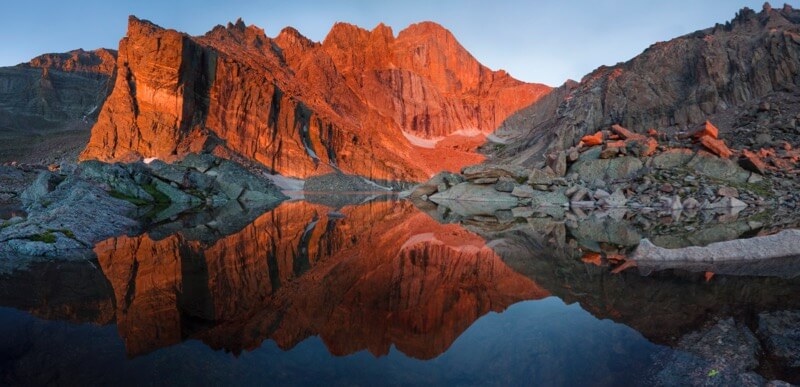
“The mountains are calling, and I must go.”
-John Muir
As fun as mountain photography can be, it also comes with a long list of challenges. These challenges include both photographic challenges and the challenges that come along with being and living in the mountains. This simple guide aims to help the reader cope with the challenges of photographing in the big mountains of the world and help inspire people to care for these beautiful places.
Grant Ordelheide is a Colorado-based photographer who has been featured in Outside, Backpacker, Nat Geo Traveller and many other publications. View more of his photography on his Instagram, Facebook, and website. All photos are © copyright by Grant Ordelheide.
A Simple Guide to Photographing Big Mountains is a 5-part series dedicated to helping photographers take better alpine pictures.
Part 1: A Simple Guide to Photographing Big Mountains
Part 2: The Right Light
Part 3: Composition Tips
Part 4: Star Images
Part 5: Adding People to the Scene
Mountain Safety
As peaceful as the mountains can be, they are also vicious places. Weather, altitude, navigation, animals, and other objective hazards can strike fast and hard. After spending a substantial amount of time in the mountains, photographers are sure to encounter one or more of these hazards. I myself have been lost in the middle of the night, seen people get hit by falling rocks, been surprised by storms, and come down with some serious altitude sickness. Most problems can be avoided by following some basic safety tips:
- Always give someone detailed instructions of where you will be traveling.
- Always carry basic survival supplies: food, water, extra clothing, a compass and map, a lighter, and a first aid kit.
- Avoid getting caught in adverse weather. Pay attention to forecasts and watch the weather closely, especially above timberline.
- Avoid loose or treacherous terrain. If you must be in rock fall zones, move through as quickly as possible.
- Pay attention to altitude sickness and other sicknesses before the symptoms get really serious.
- Have fun and be smart!
Pala Group, Dolomites, Northern Italy
Mamiya 645 55mm lens Velvia 50 Film, 1/60th at f/16 ISO 50
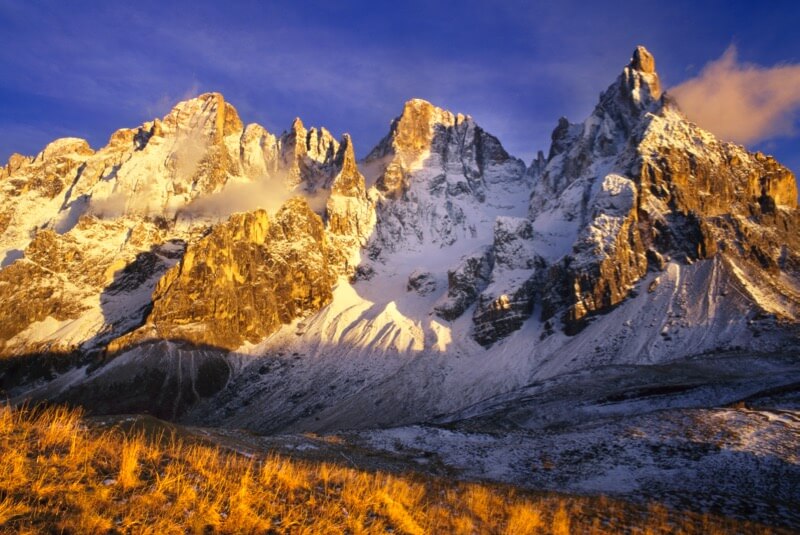
Weather
Weather is one of the trickiest parts of photographing in the mountains. Not only can weather disrupt an otherwise beautiful trip in the mountains, it can also limit what you are able to do photographically. Mountains can create their own weather, so oftentimes storms can come out of nowhere. Your life will be much easier and your photos much better if you plan ahead of time while looking at the weather prospects.
Whenever I am planning a trip to the mountains, I am constantly scanning the weather forecasts and radars. I look at the last several weeks to get an idea of what the patterns are. This way, I am prepared to deal with the weather in both a physical and creative way. I usually prefer to have some specific sort of weather pattern for my photos. Cloudless days are great for long days of hiking or climbing, but they rarely make for interesting photos. Some of my favorite images were taken on the verge of terrible weather conditions. Don’t be afraid to get out there in bad weather, just make sure you are prepared for it.
Mammatus Clouds, Cirque of the Towers, Wind River Range Wyoming
Canon 5d Mark III 17-40mm Lens, 1/6th at f/14 ISO 50
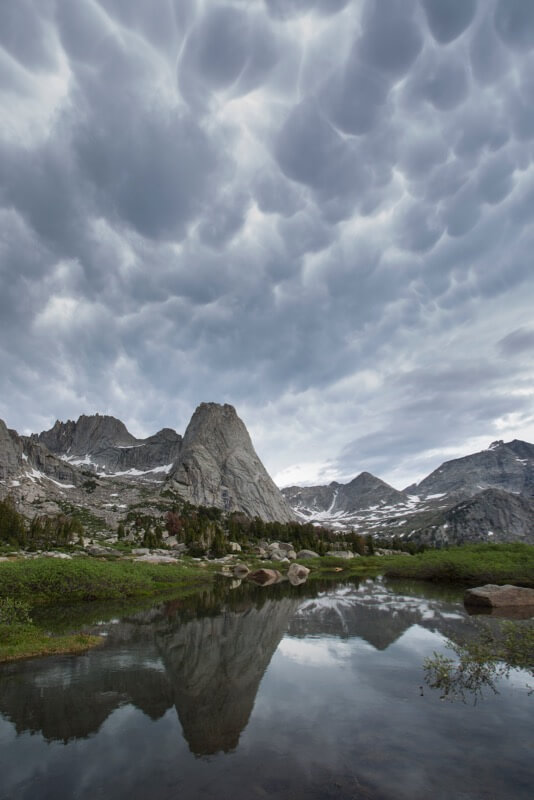
Lenticular Clouds over Torres del Paine, Chilean Patagonia
Canon 5d Mark II 17-40mm Lens, 1.6 sec at f/10 ISO 50
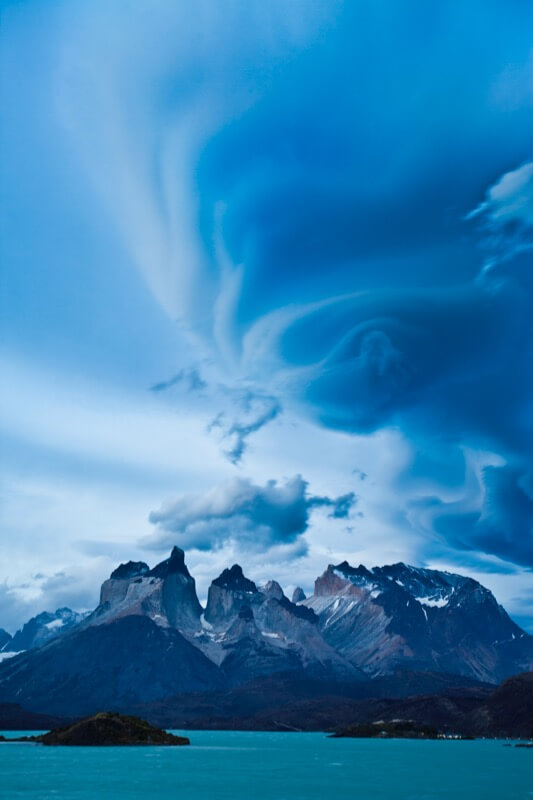
Preparation
It is obvious that spending time in the mountains requires preparation. People that go into the mountains unprepared are usually the ones whose stories becomes the material of books and movies. But being prepared in a photographic sense is just as important. The best piece of advice I can give for creating dynamic images is to put yourself out there during dynamic conditions. Now, obviously, that is easier said than done, but there are a number of ways in which you can up your chances of being in the right place at the right time.
Weather
I mentioned weather before, but mainly for dealing with it in a physical way. If that wasn’t enough reason to be aware of the weather forecast, knowing about the weather ahead of time can also drastically affect the photos you take. A rainy forecast means I will bring different gear than when it is dry. Overcast means I can usually photograph details during the day, when the light would otherwise be too harsh. If I see clear skies, I will often plan to stay up late and shoot stars. Learning how to read the radars makes it easier to predict good light and take better photos.
Natural Phenomena
Is there anything interesting going on while you will be there? Moonrise/moonset? Eclipses? Aurora Borealis? Comets? Become aware of any upcoming phenomena and figure out how to get at the right place at the right time. Apps, such as The Photographer’s Ephemeris (also available on the desktop), show sunset/sunrise and moonset/moonrise times, as well as the angles, all over a map that makes things really easy to plan. Planning for these events could make the difference between nailing a moonrise shot over a peak, and coming the day before or after a full moon.
Seasons
Plan long-term. Think about which season is best to shoot a given location. Are there deciduous trees in the shot? Maybe it would be better to come back in the fall. Will a lake freeze? Will the wind keep snow off of the lake? Try waiting until winter. Not only does the scene change as the seasons do, but so does the light. The sun is at its farthest north during the summer equinox (usually in June), and it is as far south as it will get during the winter (usually in December). These changes can determine whether a particular face of a mountain even receives light. Therefore make sure to look it up (on The Photographer’s Ephemeris) before you go.
Inspiration
Look at other photographers’ shots of a given location. There is nothing wrong with using sites like Flickr, Google Earth, Google Images, or 500px to look at photos of a location you want to visit. It gives you a great idea of the topography and lets you know what has already been done in a given location.
It took lots of planning and preparations for me to be able to make this image of Upper Cathedral Lake. I had checked out this lake on Google Earth and found the perspective I hoped to shoot from. I hiked up there and fine-tuned this composition. The light wasn’t exactly what I was hoping for, but I went through the motions of photographing it anyway. From there, I bided my time, closely watching the weather satellites. When a storm finally came and looked like it would break up at sunset, I hiked up to the lake and was able to go right back to my spot and make this image.
Upper Cathedral Lake, Yosemite National Park, California
Canon 5d Mark II 24-105mm Lens, .8 sec at f/14 ISO 50
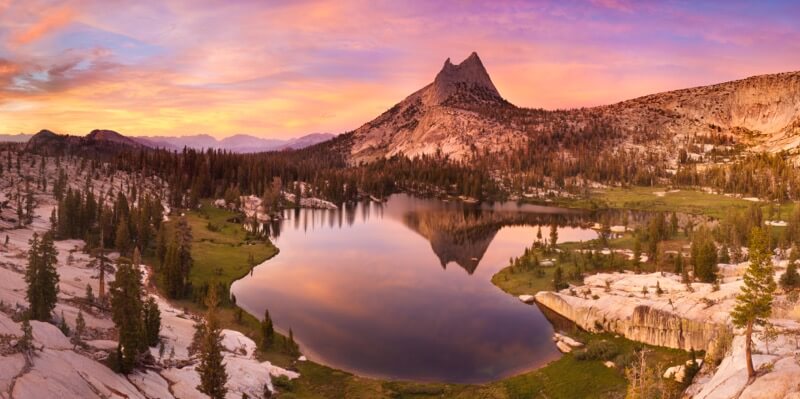
Gear
I get asked all the time what gear I take into the mountains for photography. This is very subjective and will vary depending on the situation. For me, the most important aspect of gear is weight. If I have to carry something for long distances and periods of time, weight becomes very important. I usually just try to bring the essentials: a wide angle zoom lens, a medium telephoto zoom lens, plenty of memory cards and batteries, and a few miscellaneous accessories (filters, cable release, etc.). Furthermore, I always take a small lightweight carbon fiber tripod. I also try to take non-photography gear for my camera, such as a solar charger (if I am out for weeks at a time), a quick drying towel, a waterproof cover, etc.
Sometimes the most important gear to take along are the things that will make your life the most comfortable in the mountains: warm and waterproof clothing, good food, a comfortable mattress, and a warm sleeping bag. These things can really improve your quality of life in the mountains. While the right gear is important, good gear does not take good photos by itself. The best thing you can do for your photography is to get out and take pictures!
Blue Lakes, Sneffles Wilderness, Colorado
Canon 5d Mark II 17-40mm Lens, 30 sec at f/16 ISO 50
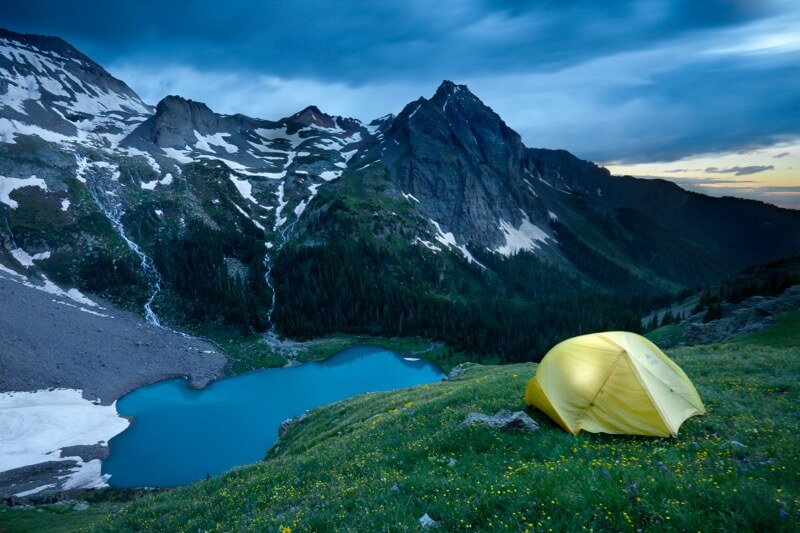
Check out part 2: The Right Light

